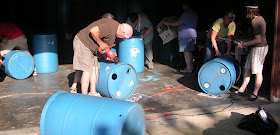Only I didn’t.
I’m fresh from getting my rain barrel set up to start catching water for the year, however, so I thought it was time to fill you in the process in case you’re interested in making your own.
Why bother? For starters, in the summer, as much as 40 percent of a homeowner’s water use goes to the yard. And a rain barrel can save you about 1,300 gallons of water during peak summer months. So whether you’re hoping to conserve a precious natural resource or simply save some cash (I’m all for both), installing a rain barrel makes sense.
But enough blabbering on about the benefits. Let’s get to the good stuff, shall we?
[All instructions below are courtesy of the Ecology Action Center. They’re great people. You should donate to them. Also, my apologies for the lack of photos. Conservative Boy thought I was crazy and didn’t tag along to assist me. Sad.]

Here’s what you need:
- One food-grade 55-gallon plastic barrel
- ½-inch female sillcock (this is the spigot)
- Two #15 O-rings (these are little black rubber rings)
- ¾-inch flat washer (we used grade 8)
- ½-inch brass pipe nipple (this is the threaded pipe that passes through the barrel and connects to the spigot/sillcock)
- ½-inch brass lock nut
- downspout adaptor
- ¾-inch pan head screws
- Hacksaw or jigsaw or sabresaw or Sawz-All
- 4-inch hole saw
- 7/8-inch hole saw
- 1¾-inch hole saw
- Drill
Here’s what you do:
- Use the 4-inch hole saw to cut a hole in the top of the barrel for your downspout.
- Use a 7/8-inch hole saw to cut a hole 3 inches up from the bottom of the barrel for your spigot/sillcock.
- Also use the 7/8-inch hole saw to cut a hole about 2 to 3 inches from the top of the barrel. This will be at the narrow part of the barrel and is where you will start to cut off the top of the barrel with your saw.
- Use the hacksaw or jigsaw or sabresaw to remove the top of the barrel. (Yes, I really did use the power tools myself, although I had a bit of help a few times.)
- Wipe any residual oil or liquid from the barrel. (We used newspapers to absorb the liquid. It worked well but it can get incredibly messy. So wear old clothes and whatever you do, don’t clean this out inside your house!)
- Use the 1 ¾-inch hole saw to cut a hole about 2 inches below the open top of the barrel. This will be for the overflow.
- Screw the pipe nipple into the spigot/sillcock.
- Place an O-ring on the pipe nipple, as close to the sillcock as possible.
- Push the pipe nipple through the outside of the barrel to the inside. The spigot/sillcock is now outside, with the pipe nipple inside.
- Have someone hold the spigot outside while you place an O-ring on the pipe nipple inside the barrel.
- Place the metal washer over the pipe nipple.
- Thread the brass lock nut (or the steel conduit locknut) over the pipe nipple. Tighten it by hand as far as possible. Tighten another 1.5 turns with a wrench to secure it.
- Take the 4-inch plastic disc that you cut out of the top of the barrel and use a saw to cut it in fourths, like a piece of pie. (Speaking of pie, I can’t wait until it’s time for strawberry rhubarb season. But, as usual, I digress.)
- Screw the pieces to the sides of the barrel near the top, with at least 1 inch protruding above the barrel.
- Place the lid of the barrel back on the barrel. The little plastic pieces will keep it centered. The lid usually only fits one way; line that up by referring to the hole you drilled near the top of the barrel when you cut off the top.

One last step: When you position your rain barrel where it belongs, you'll likely want to stack some bricks beneath so it is raised off the ground a bit. This makes it easier to get to the spigot when it's time to hook up the hose or fill up your watering can.

And that’s it! Almost. Depending on where you position your rain barrel, overflow may be a concern. I know I don’t want to be responsible for flooding our basement or the neighbors’ yard.
One option for overflow is to place the male connector end of a sump hose, pointing outward, into the overflow hole at the top of the barrel. A trap adaptor will secure it to the inside of the barrel. The sump pump hose will connect to the outside of the barrel.
Another option is to purchase a downspout diverter, like this one from Garden Water Saver. That’s what I did, only our crappy old gutter wasn’t very cooperative and, to be honest, I’m not sure that it’s a very reliable setup. So I may be going back and drilling that overflow hole, then sticking with the original downspout adaptor after all. We’ll see—it's raining today, so this will be the test.

If you’re looking for more step-by-step info on making a rain barrel, watch Sherry & John in action over at This Young House as they build their own. Fun stuff, my friends.



Oooh Julie, you're really good at this. Thank you for sharing this detailed steps on rain barrel making. Hehe! What do you think is better to use -- wood or plastic? Wood seems a little vintage and cool, though. I also read from other articles that we can make more than 1 barrel to maximize some space in our backyard.
ReplyDelete